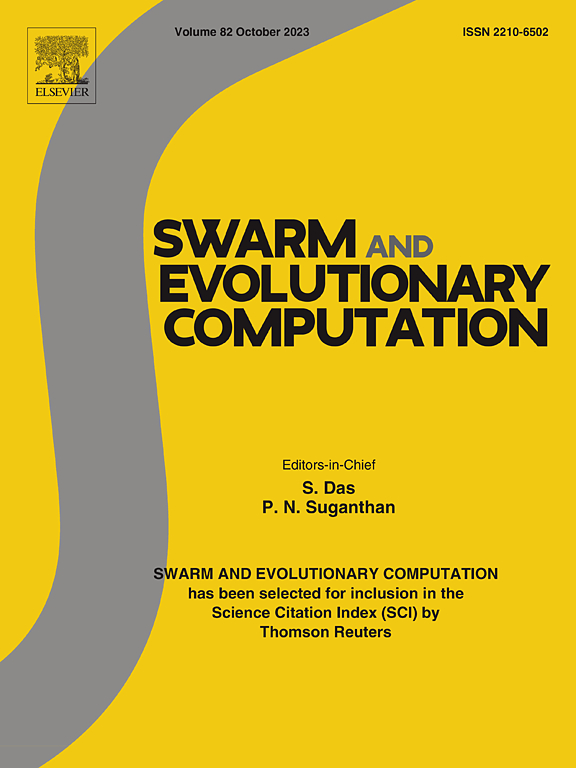基于改进遗传算法和克隆选择优化的门控循环单元网络地震震级预测
IF 8.5
1区 计算机科学
Q1 COMPUTER SCIENCE, ARTIFICIAL INTELLIGENCE
引用次数: 0
摘要
地震震级预测是预测人类安全、经济和财产损失的重要手段。地震发生过程是一个高度复杂的非线性问题。与此同时,人工智能方法已经成为解决震级预测挑战的自动化和智能框架。然而,这些方法忽略了冗余特征,预测精度较低。遗传算法(GA)在特征选择方面具有优势,门控循环单元(GRU)具有较强的时间序列预测能力。为此,我们提出了一种新的地震震级预测方法——改进遗传算法和基于克隆选择优化的遗传算法(IGA-CSOGRU)。首先,提出了一种带代沟策略的改进遗传算法,提高了预测模型中时间序列数据的特征选择能力。其次,将GRU作为核心预测模型实现。为了优化其超参数,提出了拉丁超立方体采样与自适应变异CSO相结合的方法,提高了预测性能。最后,为了验证所提出的IGA-CSOGRU的性能,构建了一个新的地震震级预测数据集,该数据集来自自主开发的声学&;电磁到人工智能(AETA)平台。评估指标如均方根误差(RMSE)、平均绝对误差(MAE)、均方误差(MSE)和R2用于评估。提出的IGA-CSOGRU模型在所有数据集上都显示出显著的性能改进,与所有基线方法相比,平均RMSE降低了5%-7%,突出了该模型在处理具有挑战性的时间序列预测任务方面的卓越能力。支持本研究结果的实现代码可在https://github.com/123fggv/Earthquake-prediction上获得。本文章由计算机程序翻译,如有差异,请以英文原文为准。
An improved genetic algorithm and clone selection optimization-based gated recurrent unit networks for earthquake magnitude prediction
Earthquake magnitude prediction is a vital rendezvous for human safety, economic and property losses. The earthquake occurrence process represents a highly complex nonlinear problem. Meanwhile, artificial intelligence methods have emerged as automated and intelligent frameworks for addressing magnitude prediction challenges. However, these approaches ignore redundant features and have lower prediction accuracy. Genetic Algorithms (GA) excel in feature selection and Gated Recurrent Units (GRU) have strong time series prediction capabilities. Therefore, we propose a novel earthquake magnitude prediction method, named Improved GA and a Clone Selection Optimization-based GRU (IGA-CSOGRU). First, an improved GA with generation gap strategy is presented to enhance the feature selection capability of time-series data in prediction models. Second, GRU is implemented as the core prediction model. To optimize its hyperparameters, a novel approach combining Latin hypercube sampling with adaptive mutation CSO is introduced, thereby enhancing prediction performance. Finally, to validate the performance of the proposed IGA-CSOGRU, a novel earthquake magnitude prediction dataset is constructed, which is acquired from the self-developed Acoustic & Electromagnetics to AI (AETA) platform. Evaluation metrics such as Root Mean Squared Error (RMSE), Mean Absolute Error (MAE), Mean Squared Error (MSE), and were used for assessment. The proposed IGA-CSOGRU model demonstrates significant performance improvements across all datasets, achieving an average RMSE reduction of 5%–7% compared to all baseline methods, highlighting the model’s superior capability in handling challenging time series prediction tasks. The implementation code supporting the findings of this study is available at https://github.com/123fggv/Earthquake-prediction.
求助全文
通过发布文献求助,成功后即可免费获取论文全文。
去求助
来源期刊

Swarm and Evolutionary Computation
COMPUTER SCIENCE, ARTIFICIAL INTELLIGENCEC-COMPUTER SCIENCE, THEORY & METHODS
CiteScore
16.00
自引率
12.00%
发文量
169
期刊介绍:
Swarm and Evolutionary Computation is a pioneering peer-reviewed journal focused on the latest research and advancements in nature-inspired intelligent computation using swarm and evolutionary algorithms. It covers theoretical, experimental, and practical aspects of these paradigms and their hybrids, promoting interdisciplinary research. The journal prioritizes the publication of high-quality, original articles that push the boundaries of evolutionary computation and swarm intelligence. Additionally, it welcomes survey papers on current topics and novel applications. Topics of interest include but are not limited to: Genetic Algorithms, and Genetic Programming, Evolution Strategies, and Evolutionary Programming, Differential Evolution, Artificial Immune Systems, Particle Swarms, Ant Colony, Bacterial Foraging, Artificial Bees, Fireflies Algorithm, Harmony Search, Artificial Life, Digital Organisms, Estimation of Distribution Algorithms, Stochastic Diffusion Search, Quantum Computing, Nano Computing, Membrane Computing, Human-centric Computing, Hybridization of Algorithms, Memetic Computing, Autonomic Computing, Self-organizing systems, Combinatorial, Discrete, Binary, Constrained, Multi-objective, Multi-modal, Dynamic, and Large-scale Optimization.
 求助内容:
求助内容: 应助结果提醒方式:
应助结果提醒方式:


